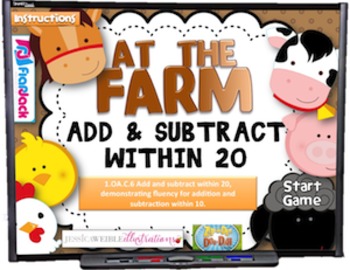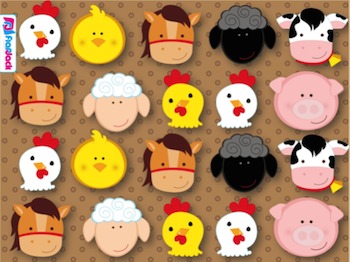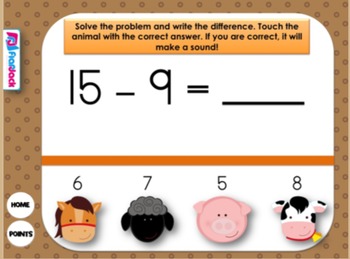Add and Subtract Within 20 Smart Board Game
FlapJack Educational Resources
24.2k Followers
Grade Levels
K - 2nd
Subjects
Resource Type
Standards
CCSS1.OA.C.6
Formats Included
- NOTEBOOK (SMARTboard) File
Pages
23 pages
FlapJack Educational Resources
24.2k Followers
What educators are saying
My students enjoyed playing this game to practice math skills. It was engaging and reinforced what we were working on in class.
Also included in
- Introducing the ultimate interactive math game bundle for your first graders. This pack is jam-packed with 15 math games that are a perfect fit for both Smart Board and Promethean platforms. It's all about making math super engaging and fun!Key Features:Common Core Standards Alignment:Every game isPrice $17.99Original Price $28.58Save $10.59
Description
In this Smart Board game, students practice adding and subtracting within 20 with farm animals that make noises when students touch the right answer! This game is self-checking, interactive, and can be used in small groups or as a whole group review.
Wait! Before you purchase, this resource is only $1 in my 1st Grade SB Math Game Pack. The majority of the 1st grade math common core standards are covered in this pack.
Also Available:
4th Grade SB Math Pack
3rd Grade SB Math Game Pack
2nd Grade SB Math Game Pack
Kindergarten SB Math and Literacy Game Pack
Thanks for your visit!
Tabitha Carro
Connect with FlapJack!
Wait! Before you purchase, this resource is only $1 in my 1st Grade SB Math Game Pack. The majority of the 1st grade math common core standards are covered in this pack.
Also Available:
4th Grade SB Math Pack
3rd Grade SB Math Game Pack
2nd Grade SB Math Game Pack
Kindergarten SB Math and Literacy Game Pack
Thanks for your visit!
Tabitha Carro
Connect with FlapJack!
Total Pages
23 pages
Answer Key
N/A
Teaching Duration
N/A
Report this resource to TPT
Reported resources will be reviewed by our team. Report this resource to let us know if this resource violates TPT’s content guidelines.
Standards
to see state-specific standards (only available in the US).
CCSS1.OA.C.6
Add and subtract within 20, demonstrating fluency for addition and subtraction within 10. Use strategies such as counting on; making ten (e.g., 8 + 6 = 8 + 2 + 4 = 10 + 4 = 14); decomposing a number leading to a ten (e.g., 13 - 4 = 13 - 3 - 1 = 10 - 1 = 9); using the relationship between addition and subtraction (e.g., knowing that 8 + 4 = 12, one knows 12 - 8 = 4); and creating equivalent but easier or known sums (e.g., adding 6 + 7 by creating the known equivalent 6 + 6 + 1 = 12 + 1 = 13).






